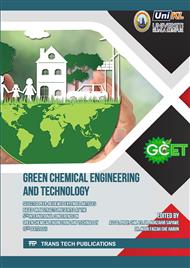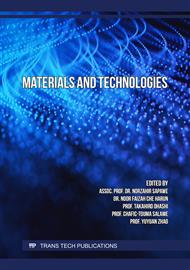p.143
p.151
p.163
p.171
p.181
p.193
p.205
p.215
p.221
Synthesis of Mesoporous Silica Nanoparticles from Oil Palm Frond Based Silica to Enhanced Removal of Heavy Metal
Abstract:
Industries such as electroplating, mining etc. produce wastewater that, as it includes various heavy metals such as lead, cadmium, has a potential threat to our environment. If this wastewater is left untreated, soil and water supplies would be polluted. The release of heavy metals into the natural world, has resulted in a number of heavy metals that can cause serious harm to humans and marine life even at trace levels. Thus, this research address the synthesis of oil palm frond (OPF) based mesoporous silica nanoparticle (MSN) which intended for the removal of heavy metal. The MSN were synthesised from OPF via sol-gel method and later utilised as adsorbent to removed lead (Pb) from the aqueous solution. The FTIR results of OPF-based MSN exhibit similar peak with commercially available silica. The MSN adsorbent was then investigated for Pb removal under different parameter including pH, contact time, dosage, concentration, and temperature and analysed using Atomic Absorption Spectroscopy (AAS). The optimum condition was obtained at pH 7, 45 mins of contact time, 0.4 g/L adsorbent dosage under 10 ppm of Pb concentration at 303 K that aid in enhancing Pb removal by the OPF-based MSN. At this condition, MSN successfully removed up to 89% of Pb in aqueous solution with adsorption capacity of the adsorbent is within the range of 22.3 mg/g. This result demonstrates the potential application of MSN from OPF as an adsorbent in Pb removal from wastewater.
Info:
Periodical:
Pages:
221-227
Citation:
Online since:
December 2022
Authors:
Price:
Сopyright:
© 2022 Trans Tech Publications Ltd. All Rights Reserved
Share:
Citation:



